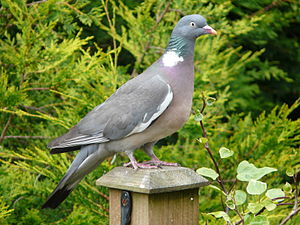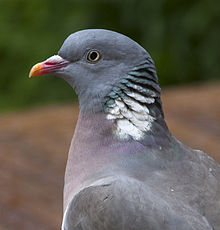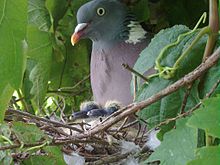- Common Wood Pigeon
-
For other uses, see Wood Pigeon (disambiguation).
Common Wood Pigeon 
Perching on a garden fence post in England
 Birdsong (help·info)
Birdsong (help·info)Conservation status Scientific classification Kingdom: Animalia Phylum: Chordata Class: Aves Order: Columbiformes Family: Columbidae Genus: Columba Species: C. palumbus Binomial name Columba palumbus
Linnaeus, 1758The Common Wood Pigeon (Columba palumbus) is a species of bird in the Columba genus in the Columbidae family. It is a member of the dove and pigeon family Columbidae. It is locally known in southeast England as the Culver.[2]
Contents
Distribution
In the colder northern and eastern parts of its Europe and western Asia range the Common Wood Pigeon is a migrant, but in southern and western Europe it is a well distributed and often abundant resident.
Description
The three Western European Columba pigeons, Common Wood Pigeon, Stock Pigeon, and Rock Pigeon, though superficially alike, have very distinctive characteristics; the Common Wood Pigeon may be identified at once by its larger size at 38–43 cm (15–17 in) and 300–615 g (11–21.7 oz), and the white on its neck and wing.[3] It is otherwise a basically grey bird, with a pinkish breast.
Juvenile birds do not have the white patches on either side of the neck. When they are about six months old (about three months out of the nest) they gain small white patches on both sides of the neck, which gradually enlarge until they are fully formed when the bird is about 6–8 months old (approx. ages only). Juvenile birds also have a greyer beak and an overall lighter grey appearance than adult birds.
Behaviour
Its flight is quick, performed by regular beats, with an occasional sharp flick of the wings, characteristic of pigeons in general. It takes off with a loud clattering. It perches well, and in its nuptial display walks along a horizontal branch with swelled neck, lowered wings, and fanned tail. During the display flight the bird climbs, the wings are smartly cracked like a whiplash, and the bird glides down on stiff wings. The noise in climbing flight is caused by the whipcracks on the downstroke rather than the wings striking together. The Common Wood Pigeon is gregarious, often forming very large flocks outside the breeding season.
Breeding
It breeds in trees in woods, parks and gardens, laying two white eggs in a simple stick nest which hatch after 17 to 19 days. Wood Pigeons seem to have a preference for trees near roadways and rivers. The nests are vulnerable to attack, particularly by crows, the more so early in the year when the leaf cover is not fully formed. The young usually fly at 33 to 34 days; however if the nest is disturbed some young may be able to survive having left the nest as early as 20 days from hatching.
Diet
Most of its diet is vegetable, round and fleshy leaves from caryophyllaceae, asteraceae, and cruciferous vegetables taken from open fields or gardens and lawns; young shoots and seedlings are favoured, and it will take grain, pine nuts, and certain fruits and berries. In the fall they also eat figs and acorns, and in winter buds of trees and bushes. They will also eat larvae, ants, and small worms. They need open water to drink and bathe in. This species can be an agricultural pest, and it is often shot, being a legal quarry species in most European countries. It is wary in rural areas, but often quite tame where it is not persecuted. Young Common Wood Pigeons swiftly become fat, as a result of the 'milk' they are fed by their parents. This is an extremely rich, sweet fluid that is produced in the adult birds' crops during the breeding season.
Call
The call is a characteristic cooing (
 Columba palumbus birdsong.ogg (help·info)).
Columba palumbus birdsong.ogg (help·info)).Subspecies
- Azores Wood Pigeon Columba palumbus azorica Hartert, 1905
- Asian Wood Pigeon Columba palumbus casiotis (Bonaparte, 1854)
- North African Wood Pigeon Columba palumbus excelsa (Bonaparte, 1856)
- Iranian Wood Pigeon Columba palumbus iranica (Zarudny, 1910)
- Madeiran Wood Pigeon Columba palumbus maderensis Tschusi, 1904 †
- European Woodpigeon Columba palumbus palumbus Linnaeus, 1758
References
- ^ BirdLife International (2004). Columba palumbus. 2006. IUCN Red List of Threatened Species. IUCN 2006. www.iucnredlist.org. Retrieved on 8 May 2006. Database entry includes justification for why this species is of least concern
- ^ in the south and east of England. cf. Oxford English Dictionary 2nd ed.; "culver" entry, 1st sense
- ^ CRC Handbook of Avian Body Masses by John B. Dunning Jr. (Editor). CRC Press (1992), ISBN 978-0849342585.
External links
Categories:- IUCN Red List least concern species
- Columba
- Birds of Pakistan
- Birds of Europe
- Birds of Turkey
Wikimedia Foundation. 2010.





